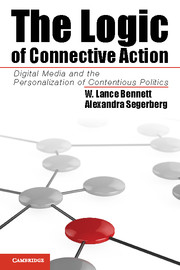Book contents
- Frontmatter
- Contents
- List of Tables and Figures
- Acknowledgments
- Introduction
- 1 The Logic of Connective Action
- 2 Personalized Communication in Protest Networks
- 3 Digital Media and the Organization of Connective Action
- 4 How Organizationally Enabled Networks Engage Publics
- 5 Networks, Power, and Political Outcomes
- 6 Conclusion
- Bibliography
- Index
Introduction
Published online by Cambridge University Press: 05 June 2014
- Frontmatter
- Contents
- List of Tables and Figures
- Acknowledgments
- Introduction
- 1 The Logic of Connective Action
- 2 Personalized Communication in Protest Networks
- 3 Digital Media and the Organization of Connective Action
- 4 How Organizationally Enabled Networks Engage Publics
- 5 Networks, Power, and Political Outcomes
- 6 Conclusion
- Bibliography
- Index
Summary
This book is about the organization of contentious political action in the digital age. Much contemporary activism still resembles the familiar protest politics of old, with people joining groups, forging collective identities, and employing a broad spectrum of political strategies from street demonstrations and civil disobedience to election campaigning, litigation, and lobbying. In the case of such traditional political action, access to digital media generally makes it easier and less costly for organizations to communicate with members and supporters. In a number of recent protests, however, digital media have shared the work of mobilizing and organizing action and, in some cases, have done more of it than did formal organizations. This shift in the underpinnings of contentious action is associated with the rise of more highly individualized publics. Such publics consist of a large number of people who experience a common problem or issue and seek common solutions, which may make them seem ripe to join traditional protest movements. In contrast with people who join conventional movements, however, these individualized publics are not inclined (or able) to join formal political organizations and prefer not to adopt definitions of their problems that require trading off personal beliefs for more restrictive group identifications. Despite the importance of communication processes and technologies in their organization, these mobilizations can be relatively stable, persistent, and effective. Indeed, they are commonly referred to as movements, as in “the Occupy Wall Street movement.” We seek to understand patterns of participation and organization in these types of collective action and to complement current thinking on how movements can be organized.
- Type
- Chapter
- Information
- The Logic of Connective ActionDigital Media and the Personalization of Contentious Politics, pp. 1 - 18Publisher: Cambridge University PressPrint publication year: 2013



